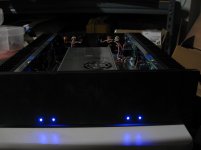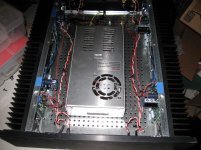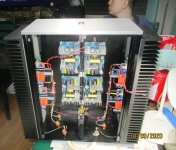Also:
Said you ain't seen, nothin'
Til you're down on the muffin
And there's sure to be a change in ways - Steven Tyler
Ha that’s awesome!
But you guys rock more \m/. Thank you for all your help and patience. Yes Mooly we got there in the end 🙂
I can only imagine this is like child birth because once I switched it on, all the pain, sweat, tears and yes, even some blood … was instantly forgotten. Mono block mode sounds incredible!
Last edited:
the simplicity and ease of build, a single gain/power stage made this ACA a clear winner, the closest a solid state amp can come close to the sound of a tube amp...
...the closest a solid state amp can come close to the sound of a tube amp...
I agree, but to my ears the ACA amp has the ability to exceed the subjective sound quality of the MC275(CE) tube amp. It also has the ability to sound worse - it depends on your loudspeakers and the mode the ACA amp is placed in, in my limited experience.
In my case, I have a pair of Klipschorns with a modified high frequency section that uses a single nominal 8Ω (8.5Ω minimum) B&C DE750 driver to cover everything above 450Hz. It's sensitivity with the Dave Harris Tractrix horn is about 108dB and that allows the ACA amp to part your hair if you're in the mood.
My Take
The ACA amp in stereo mode is lush, liquid and a little laid back compared to the MC275CE, nevertheless there is detail (reverb tails, early reflections) revealed in recordings that are much fainter with the tube amp.
In (balanced input) bridged mode the ACA amp's character sounds more like the MC275CE, particularly with instrumental detail and the higher portions of the female voice, yet the ACA amp _still_ reveals more of the nuances.
In Parallel mode the ACA amp is one of the finest amplifiers I've ever heard at any price in my system. It's better than my Mark Levinson 532H in that it's more relaxed while still revealing more detail. I have no idea how that's possible, but it's the best I can do with words. The 532H can certainly do better with large orchestral climaxes and intense rock at concert levels, but given the sensitivity of my loudspeakers, it's not a deal breaker.
Shoot me if you want, but my favorite amp at this time costs 10x the ACA amp (still much less than the 532H) and it's really complicated. The Benchmark AHB2 just seems to reveal everything and that's what turns me on the most.
Nevertheless I'd be very, very happy to live with a pair of these beautifully simple ACA amps covering the vast majority of the output from my Klipschorns in Parallel mode. What a gift they are - thank you so much Papa Pass. 🙂
God bless you and your precious family - Langston
Last edited:
ACA secret is, besides in unknown Pass Voodoo, simply in this - ultrasimple and short signal path
every other amp you have is having more stages, thus more compromises
though, your extra sensitive and efficient speakers are making possible that ACA outshines these amps, as amp output power not being limiting factor
every other amp you have is having more stages, thus more compromises
though, your extra sensitive and efficient speakers are making possible that ACA outshines these amps, as amp output power not being limiting factor
Well yes and no. I build a four channel ACA in a bigger chassis. Used a Mini Disspante 330 X 400 2U chassis as it has four heat sinks the same size the ACA chassis. It is powered by a mean well 24V 14 amp SMPS. I will try to load an image later.
I’m really impressed with my two ACAs in Parallel mode. But, the problem I seem to have is, unless I’m right in front of my speakers, it doesn’t sound great. This seems more obvious than one amp in stereo. I have Tannoy eclipse 3s and the room isn’t great either. Sitting in the sweet spot though, these things are awesome!
But, the problem I seem to have is, unless I’m right in front of my speakers, it doesn’t sound great.
You're definitely going to get a different sound with one amp in stereo mode for several reasons:
1. Stereo mode has twice the output impedance of Parallel mode, which will, just like EQ, increase the loudspeaker output where the loudspeaker impedance rises and reduce it where it dips. See my measurements above using the loudspeaker simulation circuit for reference.
2. Distortion from the ACA amps drops significantly with increasing load impedance. I recommend loudspeakers that dip no lower than about 8Ω in Stereo mode, about 4Ω in Parallel mode and about 10Ω in Bridged mode. In my limited experience with these amps, they enter world-class sonic territory when the average load (loudspeaker) impedance is about twice has high as these recommended minimums.
3. The distortion that these amps produce is the least objectionable I've ever experienced, and along with the variable EQ from the amp to loudspeaker due to voltage division (from the high-ish amp output impedance), it was allows you a great deal of flexibility in flavoring the sound to taste. My taste is clarity, thus I prefer Parallel mode.
4. The low wattage output of these amps obviously screams for high sensitivity loudspeakers, which I have and I'm very, very happy with these crazy inexpensive yet high-end amps. In your case with loudspeakers that output about 20dB less than mine at the same power level, you're going to have to be close to them...
...but if you have access to low shelving EQ and want to experiment, try this: Call a friend and ask if you can sleep on his couch tonight if necessary, then wait until your wife leaves the house and remove all the furniture from a room that has corners without doorways nearby. Place the loudspeakers tightly in the corners angled at 45˚ and hang blankets or other absorption material on the walls on both sides of the loudspeakers from where they meet the walls out to about a meter. Hang another blanket directly behind the listening position. Then set the low shelving filter to remove 10dB from about 100Hz downward and see what happens. 🙂
God bless you and your precious family - Langston
Last edited:
Has anyone built two ACA's in one chassis?
me, i built 4 channels in one chassis....48vdc ACA, we call Kampana....
Attachments
I’d love to see a future kit that was two ACA modules in one full size 17/19” chassis with integrated power supplies. Would expect the kit to retail for 2-3x of a single ACA kit.
The following measurements of my ACA amps are the kind of thing most folks start with, but I'm concluding with: transfer function and THD.
I chose the max wattage levels to approximate the specs seen in the "ACA V1.6 Operation modes" doc and then made lower level measurements at 5dB increments down to -5dBV drive voltage. See the plot legends for details and pay attention to the THD scales, I used a couple of different ranges to help with clarity.
As I've mentioned in a couple of prior posts in this thread, the distortion these amps produce is the most benign I've ever heard from an audio device, including tube designs. Thus I think the max level specs were probably done by ear as much as meter.
It's amazing that you have to defend the use of ones ears when characterizing something intended for listening. 🙂
God bless you and your precious family - Langston
Phase is effectively perfect
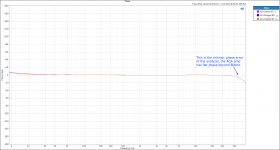
Stereo into 8Ω
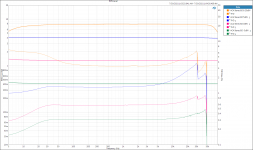
Stereo into 4Ω
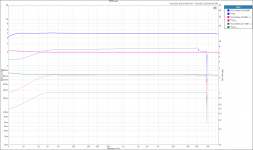
Bridged into 8Ω
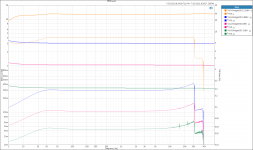
Parallel into 8Ω
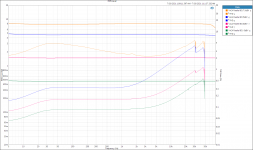
Parallel into 4Ω
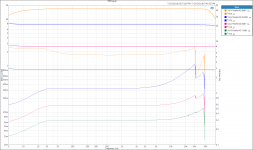
I chose the max wattage levels to approximate the specs seen in the "ACA V1.6 Operation modes" doc and then made lower level measurements at 5dB increments down to -5dBV drive voltage. See the plot legends for details and pay attention to the THD scales, I used a couple of different ranges to help with clarity.
As I've mentioned in a couple of prior posts in this thread, the distortion these amps produce is the most benign I've ever heard from an audio device, including tube designs. Thus I think the max level specs were probably done by ear as much as meter.
It's amazing that you have to defend the use of ones ears when characterizing something intended for listening. 🙂
God bless you and your precious family - Langston
Phase is effectively perfect

Stereo into 8Ω

Stereo into 4Ω

Bridged into 8Ω

Parallel into 8Ω

Parallel into 4Ω

I appreciate the level of technical expertise that goes into measurements like that, but I'm so grateful I'm not a measurement geek. Sounds good, is good, all I need to know. I'm sure I'd be horrified at the results if you measured my wonderful Sansui AU-999.
Last edited:
Perhaps more than any other discipline, audio engineering involves not only purely objective characterization but also subjective interpretations. It is the listening experience, that personal and most private sensation, which is the intended result of our labors in audio engineering. No technical measurement, however glorified with mathematics, can escape that fact. - Richard C. Heyser
Years ago one of the original engineers for Marantz briefly posted on one of the vintage forums. He explained how in the early days they would design a circuit on paper and by the numbers. Then they would get together in a group and do extensive listening tests to tweak the design for sound.I appreciate the level of technical expertise that goes into measurements like that, but I'm so grateful I'm not a measurement geek. Sounds good, is good, all I need to know. I'm sure I'd be horrified at the results if you measured my wonderful Sansui AU-999.
He also told stories of how there were several early designs that never made to final production because they didn't like the sound. Sadly he passed before he could answer the five million questions the others wanted to ask him.
As long as the sound is good and there is enough detail to not smear out the background - I'm good with it.
Then you have John Bau, chief engineer and designer of (well loved) Spica loudspeakers (link), who is active on this forum even today.
"Which one do I like best?" is the wrong question (??). Listening to gear without knowing its name is the wrong procedure (??). Very thought provoking.
_
IMO, with so many variables at play, DBT (double-blind testing) is the fast track to uniform mediocity in audio products. It's more like a game show than an evaluation tool.
... DBT asks, and answers, the wrong question during most stages of the design/development process.
Over the years I've had the pleasure of knowing quite a few top audio designers, and I can't recall a single one that used DBT as part of their process, except perhaps at the very end. Group listening sessions, sure. But not DBT.
[the wrong question is] "Which one do I like best" ... Blind listening tests can turn up some bizzarre outcomes. I once accidentally slipped a 4558 opamp into a balanced I/V converter listening comparison, and of the five it fared quite well. As a result, am I going to use it in that position? Absolutely not.
When doing comparative listening, I typically lose track of which is which anyway... aging's natural normalization of personal bias! 🙂
"Which one do I like best?" is the wrong question (??). Listening to gear without knowing its name is the wrong procedure (??). Very thought provoking.
_
Last edited:
Just finished the v1.8 ACA, straight as per the kit as it is purchased. Sound wise, how does it compared to the bigger brothers from Mr Pass?
- Home
- Amplifiers
- Pass Labs
- Amp Camp Amp - ACA

